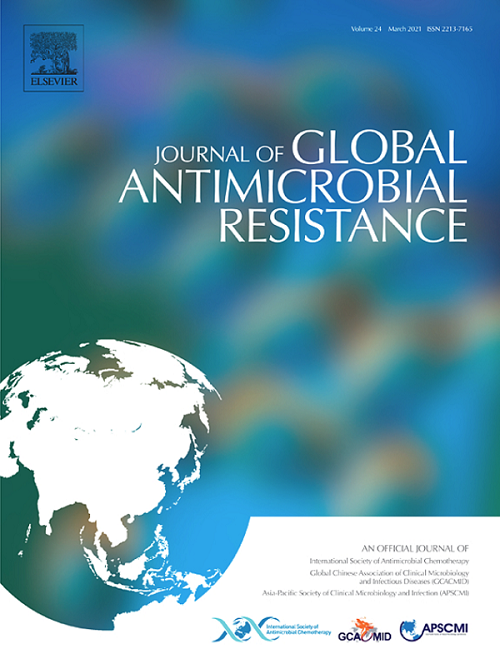耐甲氧西林金黄色葡萄球菌GG0398在荷兰的牲畜农场和肉类
IF 3.7
3区 医学
Q2 INFECTIOUS DISEASES
引用次数: 0
摘要
目的本合作监测项目的目的是调查牲畜养殖场、在这些养殖场工作/生活的人员和肉类中耐甲氧西林金黄色葡萄球菌(MRSA)的流行情况。方法采用(预)富集和选择性培养皿对2018 - 2023年收集的荷兰肉鸡、猪、小牛肉、奶牛和绵羊农场、在这些农场生活/工作的人员和零售肉类进行培养。对MRSA亚群进行新一代测序,检测mecA/mecC、Panton-Valentine白细胞杀死素(PVL)并分配基因群(GGs)。结果149个猪场中有113个(75.8%)存在MRSA。小牛肉的患病率较低(44/173;25.4%),乳制品(11/181;6.1%),绵羊(7/156;4.5%),肉鸡养殖场(0/195;0%)。在375名农场工作/生活人员中,我们鉴定出17名(4.5%)鼻腔MRSA携带者,均为农民。除2株分离株外,其余均为GG0398 (= CC398)。总共分析了4529份荷兰零售肉类样本,其中412份(9.1%)呈mrsa阳性。禽肉最常受到污染。大多数肉类分离株(97/148;65.5%),属于GG0398。除一例外,所有分离株均携带mecA,且均为pvl阴性。结论:尽管抗菌药物的使用减少了;自2009年以来,70%的兽医学,大多数猪场仍然是MRSA阳性。农民成为鼻腔MRSA携带者的风险高于一般人群。肉类经常被MRSA污染,但这对消费者来说被认为是有限的风险。几乎所有的MRSA都属于GG0398,证实了这种MRSA在牲畜和肉类中的持续优势。本文章由计算机程序翻译,如有差异,请以英文原文为准。
Methicillin-resistant Staphylococcus aureus GG0398 on livestock farms and meat in the Netherlands
Objectives
The objective of this collaborative surveillance project was to investigate the prevalence of methicillin-resistant Staphylococcus aureus (MRSA) among livestock farms, persons working/living on these farms, and on meat.
Methods
Samples from Dutch broiler, pig, veal calf, dairy cattle, and sheep farms, persons living/working on these farms and retail meat collected between 2018 and 2023 were cultured using (pre-) enrichment and selective plates. Next-generation sequencing of a subset of MRSA was performed to detect mecA/mecC, Panton-Valentine leucocidin (PVL) and to assign genogroups (GGs).
Results
On 113 of 149 (75.8%) pig farms, MRSA was present. The prevalence was lower among veal calf (44/173; 25.4%), and dairy (11/181; 6.1%), sheep (7/156; 4.5%), and broiler farms (0/195; 0%). Among 375 persons working/living on the farms, we identified 17 (4.5%) nasal MRSA carriers and all were farmers. All but two isolates from the farms belonged to GG0398 (= CC398). In total, 4529 Dutch retail meat samples were analysed and 412 (9.1%) were MRSA-positive. Poultry meat was most often contaminated. Most meat isolates (97/148; 65.5%) belonged to GG0398. All but one isolate carried mecA, and all were PVL-negative.
Conclusions
Despite the reduction of antimicrobial use by > 70% in veterinary medicine since 2009, most pig farms are still MRSA positive. Farmers have a higher risk of being a nasal MRSA carrier than persons in the general population. Meat is regularly contaminated with MRSA, but this is considered a limited risk for consumers. Almost all the MRSA belonged to GG0398 confirming the continuous predominance of this type of MRSA in livestock and on meat.
求助全文
通过发布文献求助,成功后即可免费获取论文全文。
去求助
来源期刊

Journal of global antimicrobial resistance
INFECTIOUS DISEASES-PHARMACOLOGY & PHARMACY
CiteScore
8.70
自引率
2.20%
发文量
285
审稿时长
34 weeks
期刊介绍:
The Journal of Global Antimicrobial Resistance (JGAR) is a quarterly online journal run by an international Editorial Board that focuses on the global spread of antibiotic-resistant microbes.
JGAR is a dedicated journal for all professionals working in research, health care, the environment and animal infection control, aiming to track the resistance threat worldwide and provides a single voice devoted to antimicrobial resistance (AMR).
Featuring peer-reviewed and up to date research articles, reviews, short notes and hot topics JGAR covers the key topics related to antibacterial, antiviral, antifungal and antiparasitic resistance.
 求助内容:
求助内容: 应助结果提醒方式:
应助结果提醒方式:


